Among the many aquatic creatures, Dolphins are considered unique because of their magnificent looks, playful manner, and intelligent nature.
Humans have been in contact with different types of dolphins for a very long time. Dolphins are very diverse mammals that differ in appearances, habitats, and behavior. These elegant aquatic creatures are pretty dear to humans, and most dolphins seem to like us too!
Have you ever wondered about how many types of dolphins are there in the world? If you did, you should know there are around 44 different types of dolphins – although experts argue there are as few as 40 or as many as 49.
Who knows?
There may be more!
Dolphin species live across different continents and world oceans. Moreover, their presence is often seen in rivers as well.
What Are Dolphins?
These acrobatic marine animals are a group of mammals that are part of the cetacean family. They are generally divided into four families: Delphinidae, Platanistidae, Iniidae, and Pontoporiidae.
Technically, whales fall into the same cetacea category as dolphins too. If we’re getting really technical, all dolphins are whales, but not all whales are dolphins! Moreover, you might be surprised that the well-known Orca (Orcinus orca or Killer Whale) is a type of dolphin species too!
Based on their habitats, dolphins can be classified into two classes – river dolphins and ocean dolphins.
River Dolphin Species
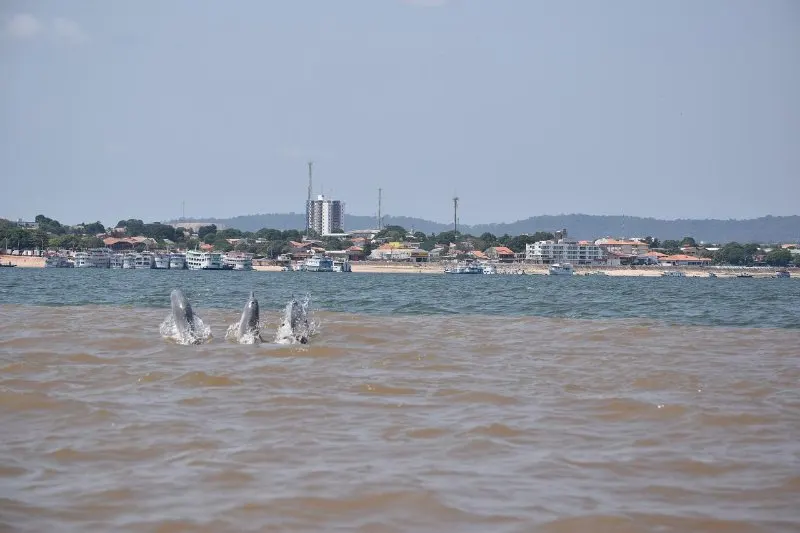
Compared to ocean-dwelling dolphins, river dolphins are found in a handful. Most river dolphins fall under the Platanistidae, Iniidae, and Pontoporiidae families.
They are widely found in big rivers like the Amazon. The Amazon River Dolphin is a renowned pink-colored dolphin species, and the Ganges River Dolphin is considered a sacred animal in the Indian subcontinent.
Ocean Dolphin Species
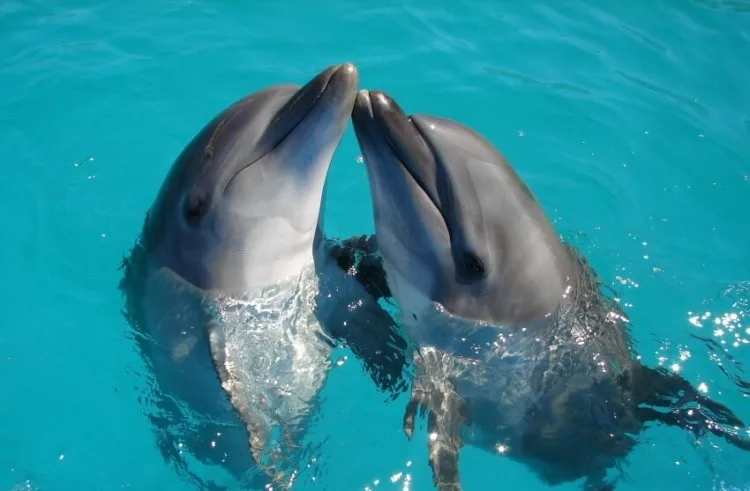
A majority of the Dolphin group dwells in the ocean. All the oceanic dolphins are under one single family: Delphinidae. Over 30 species are oceanic, indicating dolphins are more like maritime mammals like whales.
The iconic, most “dolphin-like” dolphin, the Common Bottlenose dolphin, is an oceanic dolphin species. It belongs to the Delphinidae family.
See Related: What Lives In The Deepest Part of The Ocean?
The Different Species of Dolphins
While searching for the answer to how many types of dolphins are there, we got to know many unique and exquisite dolphin species. They roam around rivers and oceans of our beautiful, blue planet.
Here is our take on 44 different types of dolphins that have been found to exist worldwide, thanks to extensive centuries of research.
But sadly, a lot of these species have been declared endangered or critically endangered. And some have even been labeled extinct by the International Union for Conservation of Nature (IUCN).
The IUCN and its subsidiaries have been working relentlessly for the conservation and proper survey of the existing world Dolphin population. It’s one of the most active organizations working in this field of marine biology.
1. Atlantic Humpbacked Dolphin (Sousa teuszii)
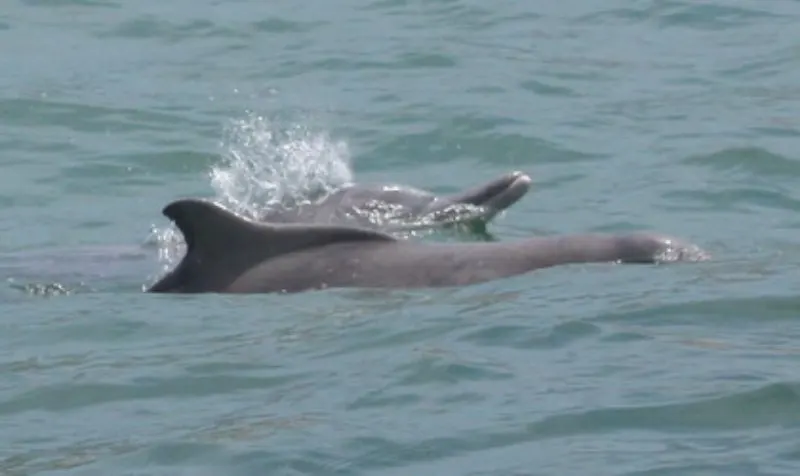
Atlantic Humpbacked Dolphins are shy. They do not bow-ride, and one may rarely see them engaging in aerial displays.
The area between Western Sahara and Angola along Africa’s west coast is where they are endemic. It primarily inhabits estuaries and shallow coastal waters.
The Atlantic humpback dolphin reportedly participates in cooperative fishing with Mauritanian Imraguen fishers by luring fish toward the coast and into their nets! You may have heard of them as they help Mauritanian Imraguen anglers lure the fish into their fishnets.
In return, the fishermen share the catch.
Their most significant concern is thought to be accidental gill net catch, followed by habitat destruction and degradation, marine pollution, climate, and anthropogenic change, and overfishing.
Status: The species is regarded as a Critically Endangered dolphin species.
See Related: Are Humans Animals? 15 Things to Know
2. Atlantic Spotted Dolphin (Stenella frontalis)
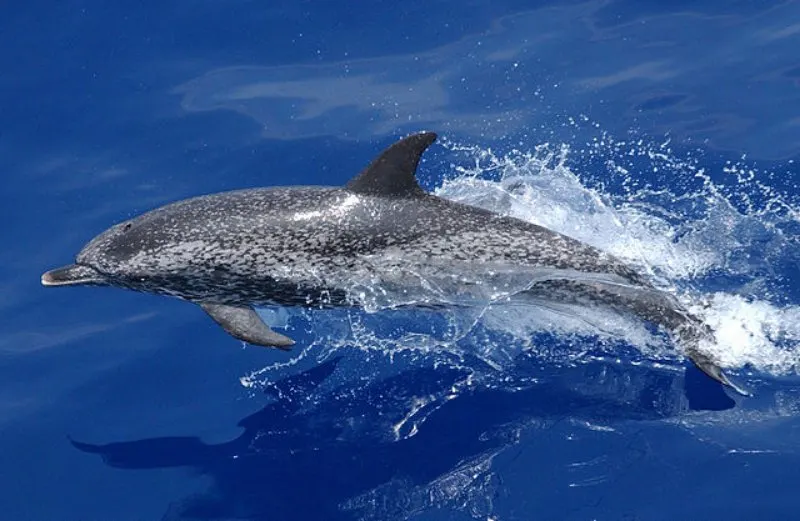
Atlantic Spotted Dolphins are easily recognizable due to their enormous size and grey spots. These magnificent dolphins roam around in tropical and temperate areas of the Atlantic Ocean.
The Bahamas and the Gulf of Mexico play host to Atlantic spotted dolphins. In addition, the coasts of Cape Cod up far north are often visited by Atlantic spotted dolphins.
Atlantic spotted dolphins are usually born with a greyish-white complexion. As the dolphins grow, their complexion changes into grey and black spots. Older Atlantic spotted dolphins have more spots on their body.
Status: The Atlantic spotted dolphins are tagged as a species of most minor concern by IUCN. Although, the recent information on the Atlantic spotted dolphins is not entirely up to date.
See Related: Habitat Loss Solutions You Need to Know
3. Atlantic White-Sided Dolphin (Lagenorhynchus acutus)
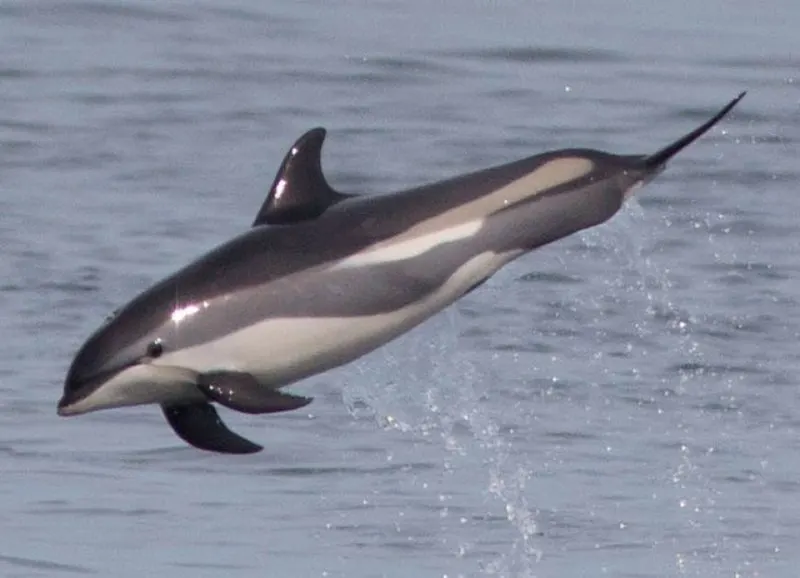
The Atlantic White-Sided Dolphin is a little larger than other ocean dolphin species. They are mainly found in the North Atlantic Ocean. You can distinguish the dolphin with a light-yellow patch behind its dorsal fin. Their belly, throat, and chin are white.
The Atlantic white-sided dolphins work together while hunting on the water surface. Atlantic White-Sided Dolphins do not participate in seasonal migration. Despite this, they wander a fixed range in search of prey.
People from Newfoundland and Norway used to kill these dolphins a lot. Their blubber and meat are highly valued as food and fuel.
Status: Atlantic White-Sided Dolphins come under the US Marine mammal protection Act. But they are not critically endangered dolphin species.
See Related: South Asian River Dolphin: Is It Endangered?
4. Australian Snubfin Dolphin (Orcaella heinsohni)

Australian Snubfin Dolphins are tricolored. Their top is brownish, the sides are light brown, and the belly is white.
The name comes from the “snubby” dorsal fin. You can easily distinguish them by looking at the fins. Australian Snubfin Dolphins have heads that are rounded, and the body is kind of melon-shaped.
Australian Snubfin Dolphins look closer to killer whales as they are their closest relatives. Australian Snubfin dolphins are endemic to Australia and are usually friendly.
Status: IUCN listed them as “vulnerable.” Fishing gear and shark nets are the actual culprits of these dolphins getting endangered.
See Related: List of Animals That Mate For Life
5. Amazon River Dolphin (Inia geoffrensis)
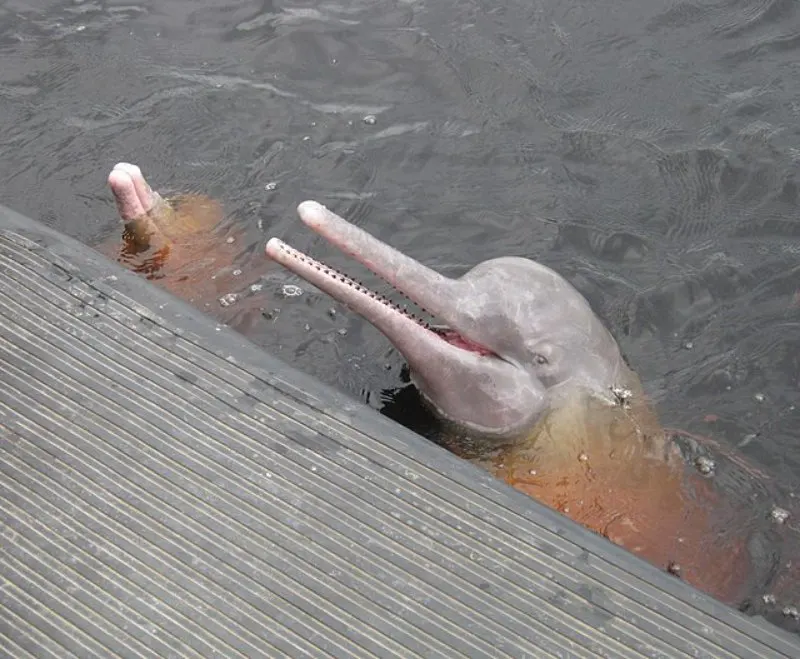
The Amazon River Dolphins are natively known as the boto or the bufeo. The boto is quite a large species of river dolphin. Amazon river dolphins are among one the few river dolphin families.
This dolphin species can grow up to 400 pounds (or 185 kgs) and can only be found in the Amazon river basin. These dolphins have long snouts with a greyish back and pinkish belly. They are often spotted near the Amazon River’s banks.
The dietary habits of Amazon river dolphins are pretty widespread. They are known to consume dozens of fish per meal. They also eat crabs and river turtles.
Status: The IUCN labeled the Amazon River dolphin as endangered. Constant human development and invasion threaten these magnificent beasts.
See Related: Hector’s Dolphin: Is It Endangered?
6. Araguaian River Dolphin (Inia araguaiaensis)
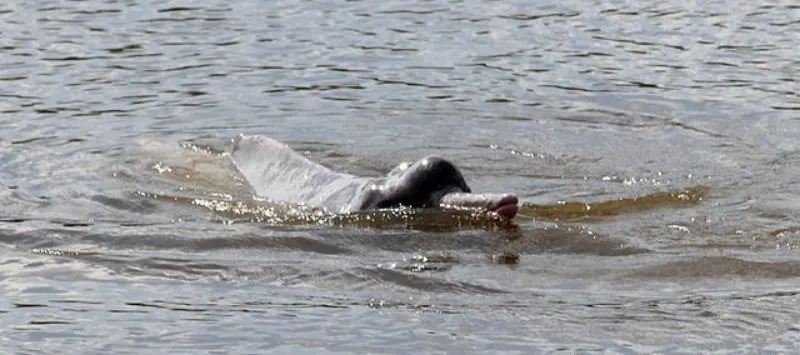
Araguaian River Dolphin is a mysterious species of dolphin. They are very poorly studied due to their remote habitat.
They are exclusive to the Araguaia-Tocantins River basin of Brazil. Often confused with the Amazon river dolphins, the Araguaian dolphins are, in fact, a distinct species.
Araguaian dolphins have a prominent forehead and long snout like other river dolphins.
Status: With an estimated 1,500 individuals left in the wild, the Araguaian dolphins are considered endangered.
See Related: The Hebridean Whale and Dolphin Trust
7. Baiji White Dolphin (Lipotes vexillifer)
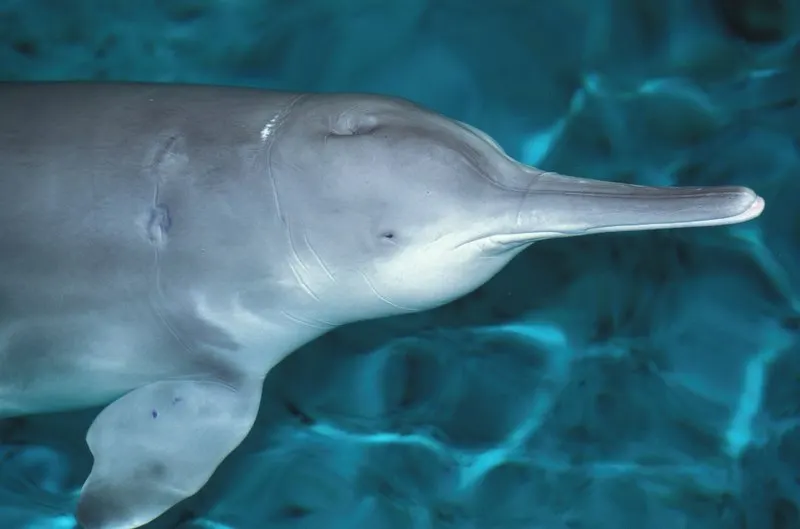
The Baiji Dolphin population declined drastically in decades as China industrialized. Moreover, they have heavily used the river for fishing, transportation, and hydroelectricity.
Some confuse the Baiji White Dolphin with certain porpoise species and White dolphins. But they are neither of them. They are also known as the Chinese River Dolphin.
They were last seen 20 years ago, and some scientists think they may have become extinct. These dolphins were so attractive that local boatmen and fishers believed them to be embodiments of a river goddess to protect them.
The main reason for them to go extinct is the industrialization of China. Heavy fishing, hydroelectricity, and transportation are also responsible. Thus, people have lost their goddess of protection.
Status: Baiji White Dolphin is “Critically Endangered,” according to IUCN.
See Related: Taiji Dolphin Hunting
8. Common Bottlenose Dolphin (Tursiops truncatus)
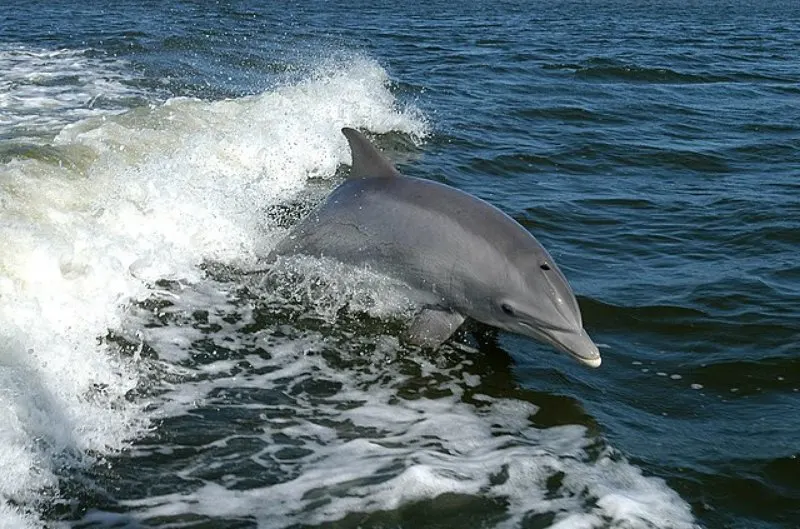
The worldwide dolphin phenomenon, the iconic Bottlenose Dolphin, is the most well-known dolphin species on Earth. Its habitat is widely spread and can be found in almost all of the world’s oceans.
Wild bottlenose dolphins are fond of warm and temperate waters. That is why you will not typically find them in icy waters in northern and southern latitudes.
Bottlenose dolphins live on small oceanic creatures like shrimps, squids, eels, or small fishes. The food habit can vary from different niches, though and every bottlenose dolphin has its own preferred favorites.
The dolphins are full of personality. They can be docile, excitable, acrobatic, playful, grumpy, and even helpful. Due to their high adaptability and playful natures, most aquariums like Sea Life have some on display.
Status: It is listed as a species of most minor concern by the IUCN.
See Related: Are Fish Endangered? What You Need To Know
9. Bolivian River Dolphin (Inia geoffrensis)
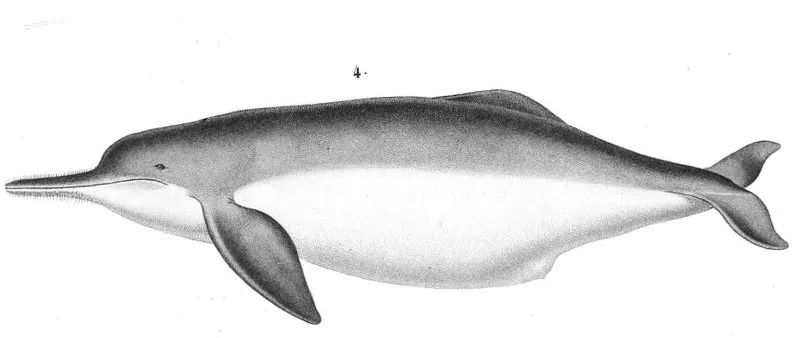
The Bolivian River Dolphin is a subspecies of the Amazon river dolphin. Discovered first in 1832 by French researchers, this dolphin species was initially thought to be a variant of the Amazon river dolphin.
However, it is the largest type of dolphin found in the rivers. An adult Bolivian river dolphin can grow up to 2.8 meters long and weigh 440 lbs (200 kgs).
Its closest cousin, the Amazon river dolphin, shows distinct similarities with the Bolivian river dolphin. However, the Bolivian river dolphin has more teeth and a larger body than the Amazon river dolphin.
This dolphin species exhibits a vastly diverse diet. It lives on various fish and crabs found in the great Amazon river.
Status: The Bolivian River dolphin species is considered endangered by the IUCN. The population of Bolivian river dolphins is rapidly declining due to deforestation and overfishing.
See Related: What is a Critical Habitat? Everything You Need to Know
10. Burrunan Dolphin (Tursiops australis)
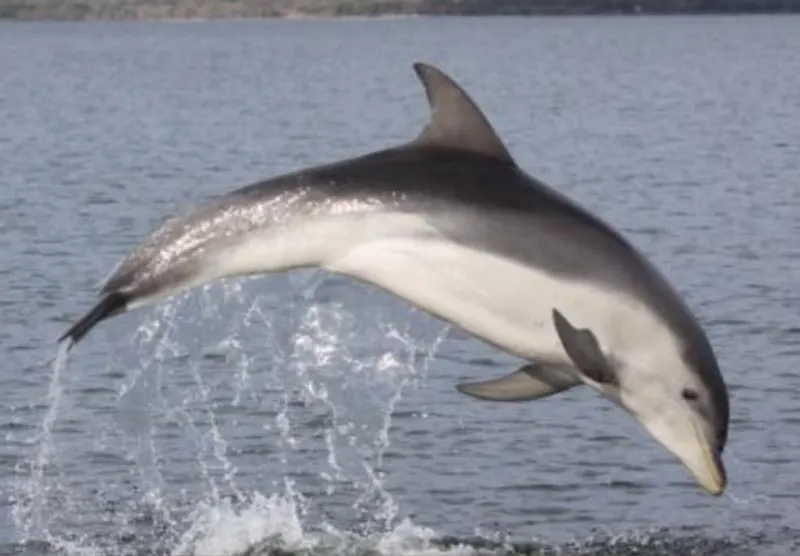
Burrunan Dolphins are mainly found around Tasmania, South Australia, and Victoria. These aquatic mammals are a bit bigger than bottlenose dolphins. You will frequently see them roam in pods.
These oceanic dolphins have a tricolored pattern on their body. It starts with dark grey on top, light grey in the middle, and cream beneath the body. Their dorsal fin is curved.
Status: IUCN has not listed Burrunan Dolphins because of data deficiencies. But an act in Victoria marks the species as Endangered.
See Related: Most Endangered Species in Alaska
11. Chilean Dolphin (Cephalorhynchus eutropia)
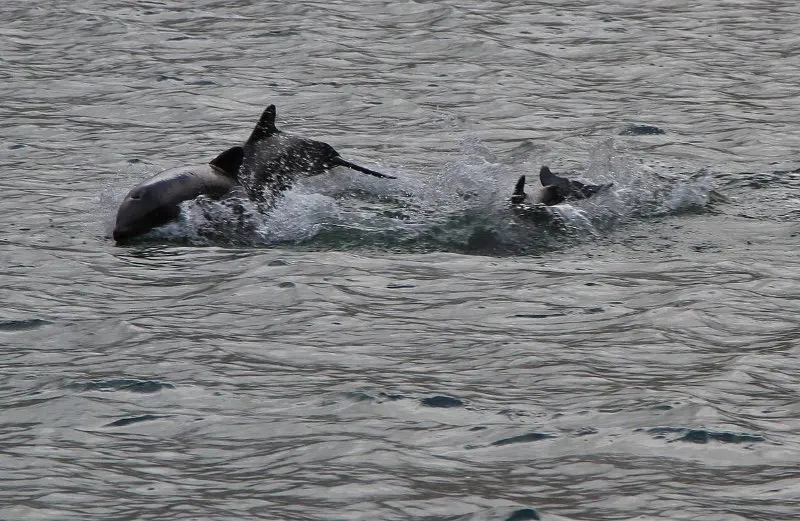
A Chilean Dolphin is also known as the Black Dolphin. You can find them only on the Chilean coast. Its local name is Tonina. Their flippers and dorsal fins are smaller compared to their body size. In addition, their throat and underside are white.
Chilean Dolphins are highly prized as their flesh can be eaten. Consequently, people harpoon thousands of them each year. Though the act has become illegal, independent fishers can continue killing them. It’s not surprising that Chilean dolphins usually avoid human contact but hang out with some other marine mammals.
Status: The Chilean Dolphin is listed as “Nearly Threatened” in the IUCN conservation status.
See Related: Angel Shark: Why Is It Endangered?
12. Indo-Pacific Humpback Dolphin (Sousa chinensis)
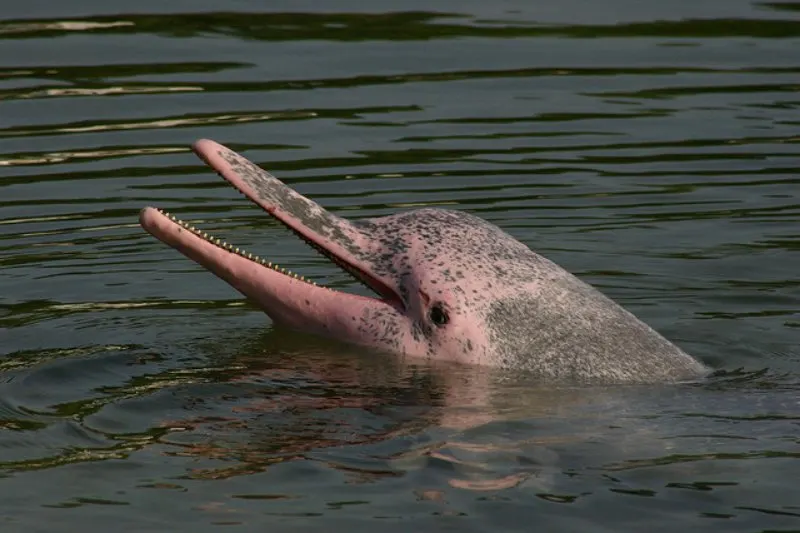
The Indo-Pacific Humpback Dolphin is a subspecies of Humpback in the Western Pacific and Eastern Indian oceans. It is called the Chinese White Dolphin in Macau, Hong Kong, Singapore, Taiwan, and mainland China.
This species belongs to the oceanic dolphin family. The mating season of the Indo-Pacific humpback dolphin starts in the summer and lasts till winter. After that, the mother takes care of the calf until it can feed itself.
These dolphins can vary in coloration. They might be grey, white or pink. There are frequent instances of albinos in the species. Indo-Pacific humpback dolphins can grow up to 11 feet and weigh up to around 500 lbs (230 kgs).
They like to roam in small groups, often consisting of not more than ten individuals to a pod. They frequently resurface to catch their breath before diving for 8 to 10 minutes.
Status: It is listed as “Vulnerable” in the IUCN. This is because of plastic pollution and other anthropogenic problems. How many dolphin species are vulnerable like this, we don’t know.
See Related: Why Were Animals So Big In The Past?
13. Clymene Dolphin (Stenella clymene)
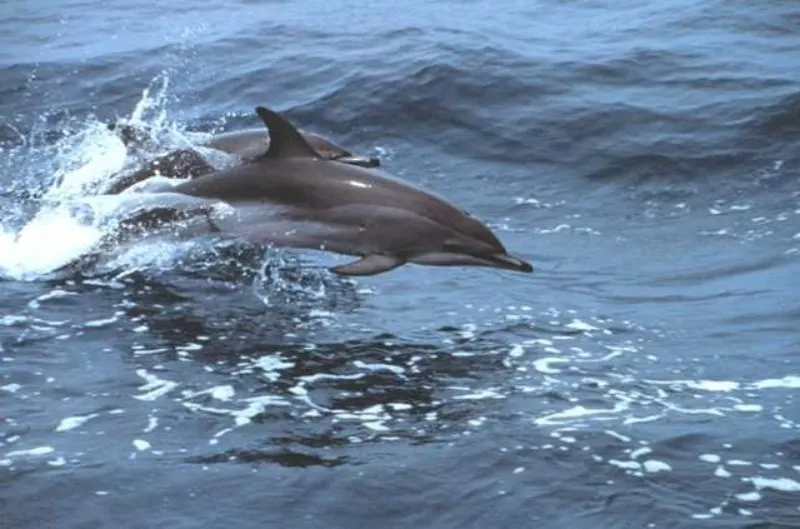
Indigenous to the Atlantic Ocean, the Clymene Dolphin is a curious and playful dolphin. It likes to reside in tropical waters. But sometimes, it is also noticed as far north as Maine.
An interesting fact about the Clymene dolphins is that they are the result of a natural hybridization of the spinner dolphin and striped dolphin. Among marine mammals, this type of hybridization is scarce.
Playful pods of Clymene dolphins are often seen riding the front of the water vessels. Clymene dolphins may travel in large groups of up to 150 individuals.
Status: The IUCN does not have enough data to determine whether this dolphin species is endangered or not. Extensive research is being carried out to determine the population data.
14. Commerson’s Dolphin (Cephalorhynchus commersonii)
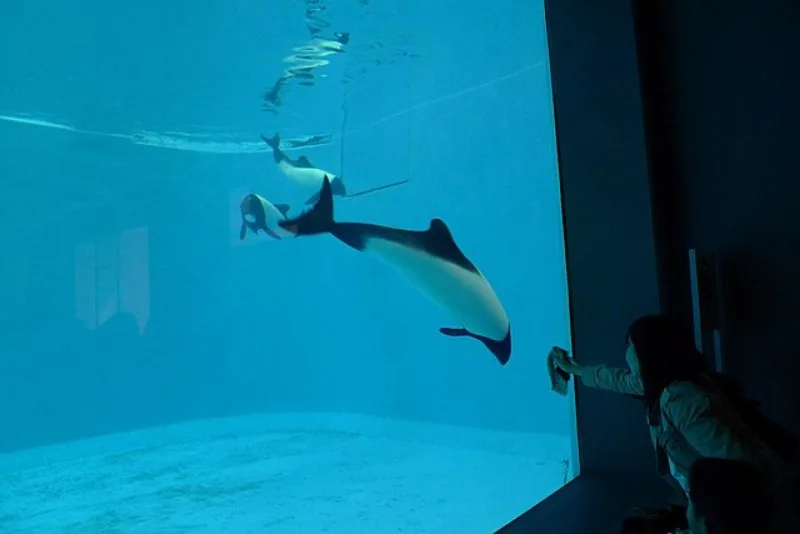
The Commerson’s Dolphin draws quite the attention for its signature look like a panda. Therefore, it is often called the jacobita or panda dolphin.
Their natural habitat lies around southern South America alongside the Kerguelen islands. It is exclusive to the waters of these regions. You will find these peculiar dolphins mostly in the Beagle channel near Tierra del Fuego and the Falkland Islands.
The colorings of the Commerson’s Dolphin are quite a sight to behold. With high contrast blackheads, dorsal fins, and tails, their shimmering white bodies resemble a panda.
Status: According to the IUCN, Commerson’s Dolphin is a species of most minor concern. But unfortunately, that might no longer be the case as constant breaching of their natural habitat is more frequent now than ever.
15. Costero/Estuarine Dolphin (Sotalia Guianensi)
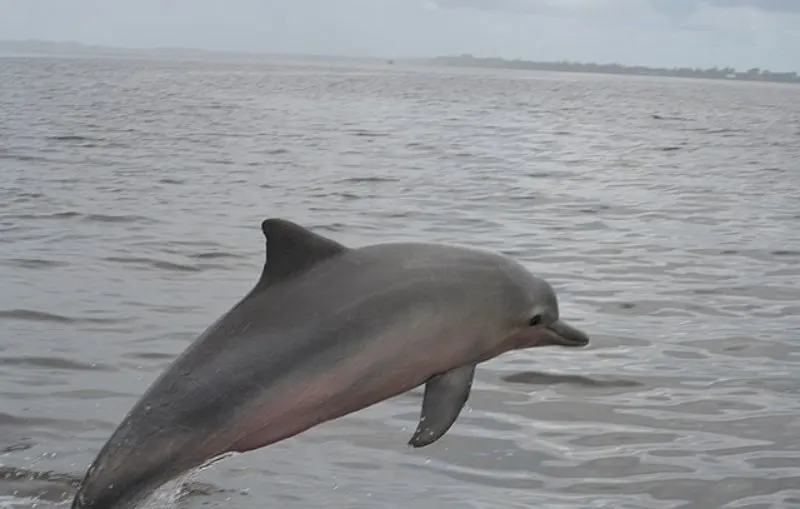
Known as Costero or Estuarine Dolphins in most areas, these marine mammals are also known as Guiana Dolphins. Interestingly they can survive in both freshwater and saltwater.
These dolphins can be found near the Northern and Eastern coasts of South America and the eastern coast of Central America.
Guiana dolphins are super active, and you may see them breaching, spy hopping, or somersaulting. A pleasure to the eyes! However, Costero dolphins will not approach your boat.
You might confuse them with bottlenose. But believe it or not, they aren’t of the same species! It is a lot smaller than common bottlenose dolphins. An adult Costero dolphin can grow up to 7 feet. Also, the dolphin is very lightly colored.
Costero dolphins are often bluish grey on their back and sides. The curved dorsal fin is sharp and hooked.
Costero dolphins feed on various schooling fish and sea vegetation. These dolphins like to forage in a group.
Status: The population of guinea dolphins is constantly dropping. Hence, their conservation status is “Nearly Threatened” by the IUCN.
16. Dusky Dolphin (Lagenorhynchus Obscurus)
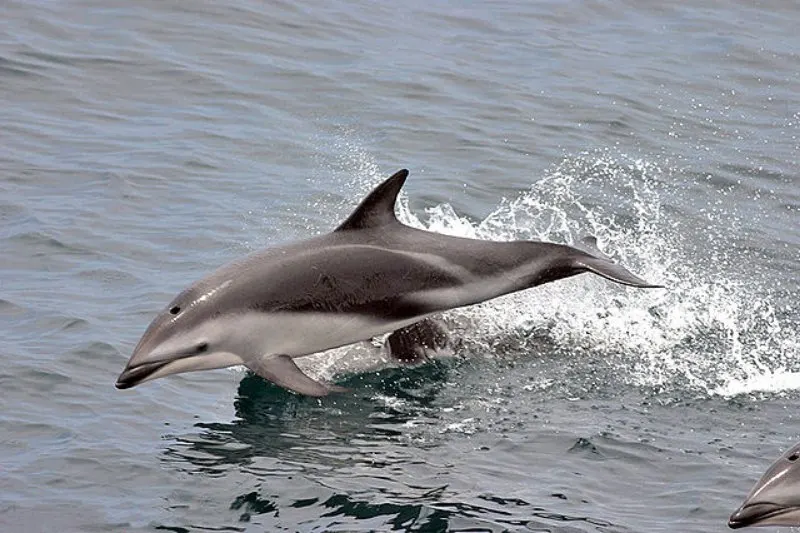
Dusky Dolphins are famous among sailors and marine travelers as they show an eccentric aerial acrobat. These playful dolphins often travel in groups and showcase impressive aerial acrobatics like jumping out of the water and spinning.
Dusky dolphins are not too big or too small. They are relatively mid-sized cetaceans found in the coastal waters in South America, the Australian coast, New Zealand, and Southern Africa.
If you are traveling by these waters, keep your eyes open. You might catch a glimpse of dusky dolphin acrobatics!
The dusky dolphin has a black back and white underside, just like the Pacific white-sided dolphin. However, the white silhouette of a dusky dolphin is different from a pacific white-sided dolphin.
For example, it contains more grey colors. These dolphins also show longer and narrower rostrums or beaks than many other dolphin species.
Status: The IUCN considers the dusky dolphin as a species of most minor concern till now, but the data on them is inadequate to determine a threat category.
See Related: Taiji Dolphin Hunting
17. False Killer Whale (Pseudorca crassidens)

False Killer Whales are found in almost every ocean and among the large-sized cetaceans. They are most fond of living in tropical and subtropical waters.
They share a striking resemblance with the killer whale or Orca. However, they are much smaller than Orcas. They are almost entirely black or deep grey.
This species of dolphin is an aggressive predator, just like killer whales. They are often spotted in large groups of 500 individuals.
Status: Due to the rapid population decline, the false killer whale is declared endangered under the IUCN.
See Related: Killer Whale: Is This Animal Endangered?
18. Fraser’s Dolphin (Lagenodelphis hosei)
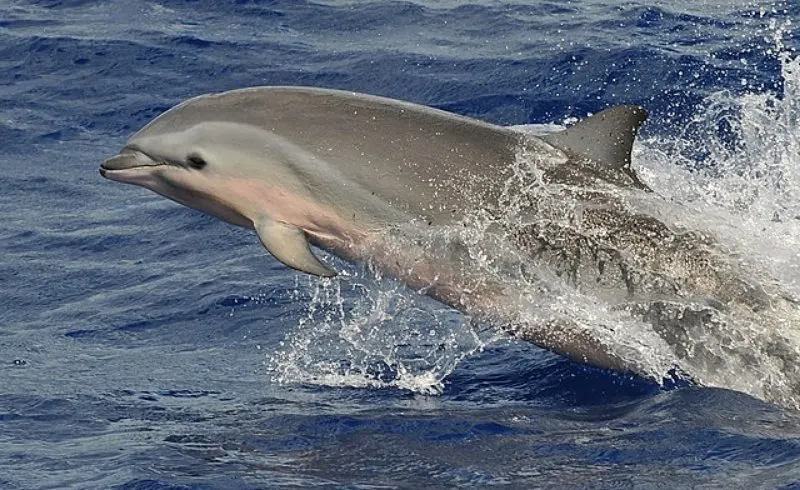
Fraser’s Dolphin was considered rare before 1980, but recent sightings tell us a different story. Recently these dolphins are seen to be increasing in numbers. However, they are not that well studied like the other dolphins.
They are medium-sized cetaceans growing up to 9 feet in length and weighing about 440 lbs (200 kgs). These dolphins have bulky bodies and small fins. The flippers are pretty small considering their colossal bodies.
The dolphins are greyish blue. An extended cream-colored stripe runs along its body. A distinguishable feature of Fraser’s Dolphin is that it does not have a prominent beak.
These dolphins can be seen around the Philippines as the country contains a large population of this species. You may find them reserved and a bit shy in some areas, but they are playful in nature.
Status: Fraser’s Dolphins are in the “Least Concerned Category” for conservation according to IUCN.
19. Ganges River Dolphin (Platanista gangetica)
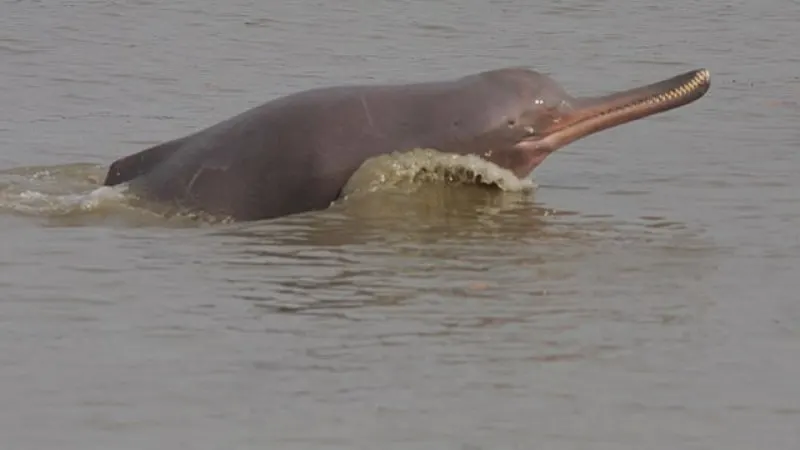
Locally named Susu or Shushuk, the Ganges River Dolphin is exclusive to India, Bangladesh, and Nepal. This freshwater cetacean is only found in the Ganges and the Ganges tributaries.
Indus river dolphins and Ganges River dolphins are closely related. But they are actually different types of dolphins. Though they share some common phenotypical characteristics, both these two species are distinguishable.
Ganges river dolphins are pretty small, with a round head and a long snout. They are either black or greyish.
Status: There are only about 3,000 Ganges River dolphins left in the wild. The IUCN listed the Ganges River dolphin as endangered. The Indian government protects these dolphins by law as it is one of the most endangered dolphin species.
20. Heaviside’s Dolphin (Cephalorhynchus heavisidii)
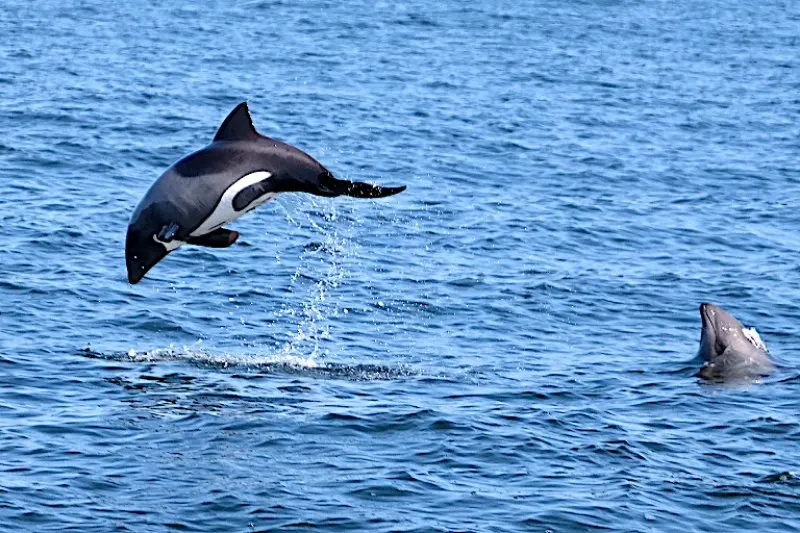
The Heaviside’s Dolphin can vertically jump out of the water’s surface and then go back to the ocean without making too much disturbance or sound. It may surprise you! You can see them roaming around in small groups near the coastal water.
These dolphins are friendly, social, and curious. So don’t be surprised if one or two come near your boat to have a better look.
These cetaceans are good swimmers with interesting acrobatic skills. They continuously search for food within their habitat range and do not migrate to other places.
Status: They are listed as “Nearly Threatened,” according to the IUCN.
See Related: Most Comfortable Animals in the World
21. Hector’s Dolphin (Cephalorhynchus hectori)
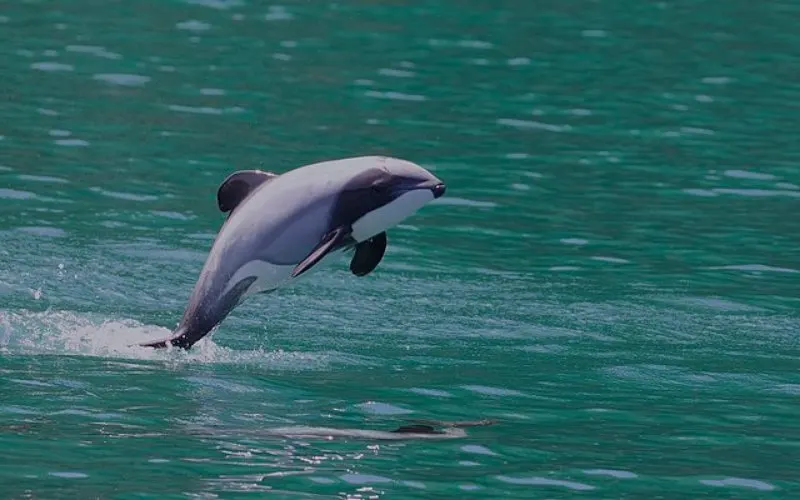
Although exclusively found in the coastal waters around New Zealand, Hector’s Dolphin is an exotic dolphin species. This dolphin is the rarest and smallest dolphin among all the oceanic dolphins found on the earth.
They are divided into two subclasses: the South Island Hectors and the Maui dolphin.
Even by dolphin standards, Hector’s dolphins are tiny. These specific cetaceans can be around 5 feet in length. An adult dolphin typically weighs only 130 pounds (or 60 kgs).
These dolphins have no perceptible beak but show a well-defined rounded dorsal fin. The pale grey complexion of these dolphins is no different from most other dolphin species.
Hector’s dolphins usually live in groups and can be seen roaming in the coastal water foraging or hunting.
Status: Due to excessive human breaching and growing viral infections, they have an alarming population decline rate. The IUCN has tagged Hector’s dolphins as endangered.
See Related: Fun and Interesting Devilfish Facts
22. Hourglass Dolphin (Lagenorhynchus cruciger)
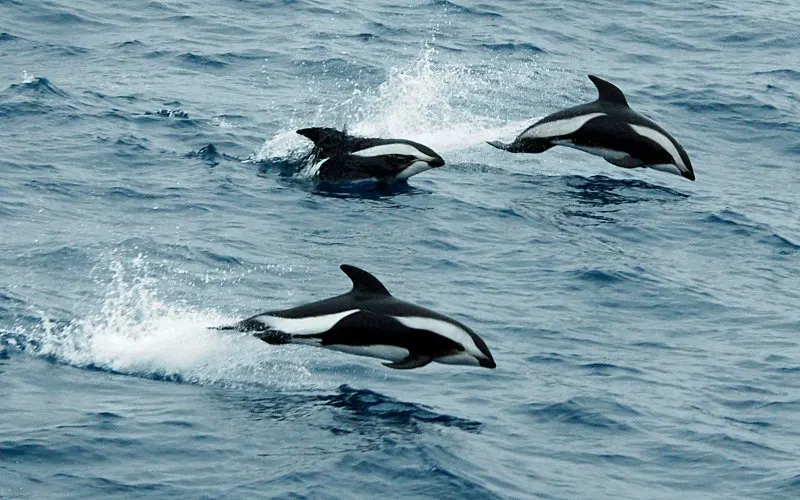
The Hourglass Dolphin can only be seen in the Arctic and sub-Antarctic waters. They can be considered one of the world’s most beautiful and exotic dolphins.
If you want to see the hourglass dolphin, get onboard a water vessel from Argentina or Chile that crosses the Drake Passage to the Antarctic Peninsula.
The hourglass dolphin is easily distinguishable. It has a sleek black body with an hourglass-like pattern. They also boast a well-defined curved dorsal fin.
The diet of hourglass dolphins does not differ from what most oceanic dolphins typically eat. Their remote habitat of the Arctic Ocean is not rich with an ample food supply like warmer waters. Still, the hourglass dolphin is comfortable with the limited food supply, since there are few other contenders for their food.
Status: The IUCN listed the hourglass dolphin as a species of most minor concern. But very little research has been conducted recently on these glorious creatures.
Eee Related: Are Fish Endangered? What You Need to Know
23. Indo-Pacific Bottlenose Dolphin (Tursiops aduncus)
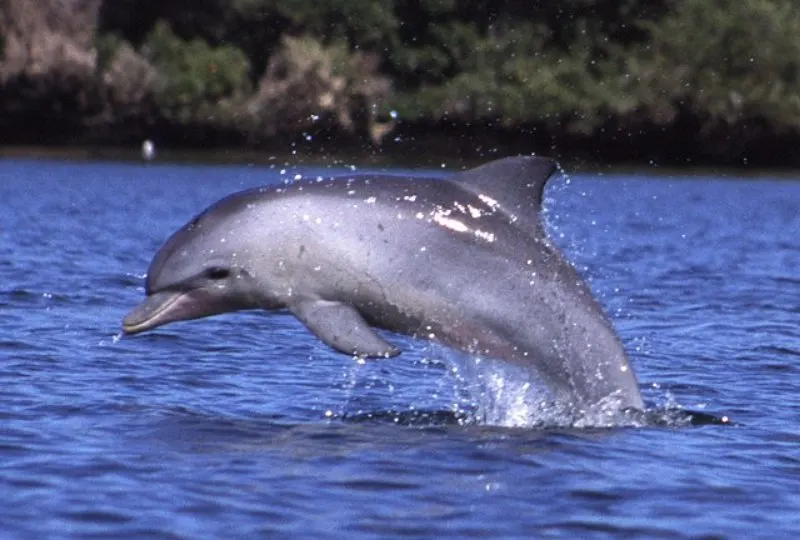
Derived from the bottlenose dolphin, the Indo-Pacific Dolphin is a medium-sized dolphin. It mostly dwells in the shore waters around India, South China, northern Australia, and the Red Sea.
Smaller than the common bottlenose dolphins, the Indo-Pacific bottlenose dolphins exhibit longer rostrum and white or grey patches around their belly. The dolphin is dark grey and has sharp, curved dorsal fins.
An adult male dolphin can grow up to 8.5 feet long and weigh up to 240 kgs. The feeding ecology of the Indo-Pacific dolphins is mainly based on various fish and squids.
These dolphins interact with common bottlenose dolphins. They associate with humpback dolphins too. These particular dolphins love to move around in groups of 15.
Status: The IUCN labeled this dolphin species as a species of most minor concern.
See Related: Types of Water Pollution You Need to Know About
24. Indus River Dolphin (Platanista gangetica minor)
The Indus River Dolphin is a dolphin species mainly found in south-central Asia. This species is called Bhulan in Urdu and Sindhi.
It only dwells in the Indus River basin and is indigenous to Pakistan and a small part of India. Pakistan considers Bhulan or Indus River dolphin a sacred animal.
The brownish dolphin has every river dolphin’s similarly long, pointy nose. Indus river dolphins do not have dorsal fins; instead, they have a small bump on the back.
Status: The IUCN declared the Indus River dolphin an endangered species.
See Related: Why Do Animals Like Being Pet?
25. Irrawaddy Dolphin (Orcaella brevirostris)
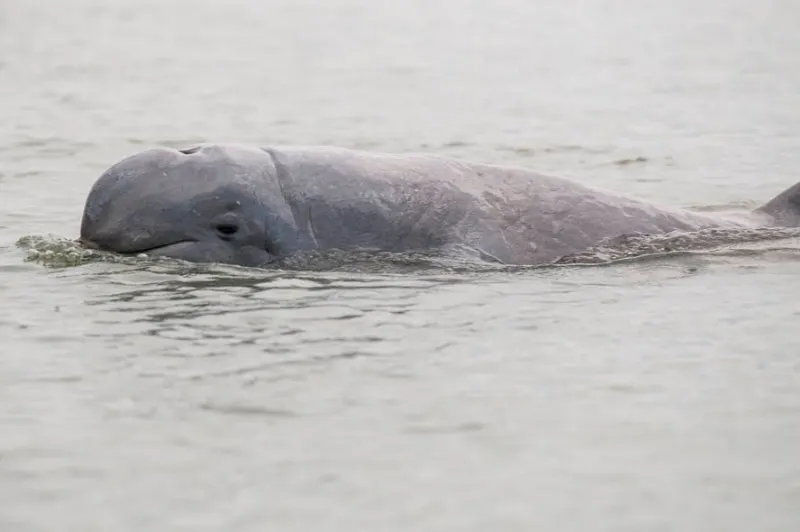
A really fascinating dolphin species is the Irrawaddy Dolphin. For many years, Irrawaddy dolphins were considered a subspecies of the Australian snubfin dolphins.
But in 2005, Irrawaddy dolphins were recognized as a different dolphin species. As a result, most Irrawaddy dolphins are seen roaming around the coastal waters of southeastern Asia.
Anatomically, the Irrawaddy dolphin is a sleek dolphin with a rounded forehead without a beak. The dorsal fin is relatively small and round. One may easily confuse the Irrawaddy dolphin with a beluga, but their wild roaming habitat differs.
They can be challenging to spot due to their shy nature. However, if you are lucky enough, one or two Irrawaddy might pay you a short visit if they get curious.
Status: IUCN has declared these cute and shy dolphins critically endangered. The declining population of the Irrawaddy dolphins is alarming.
See Related: Encouraging Endangered Species Success Stories
26. Killer Whale/Orca (Orcinus orca)
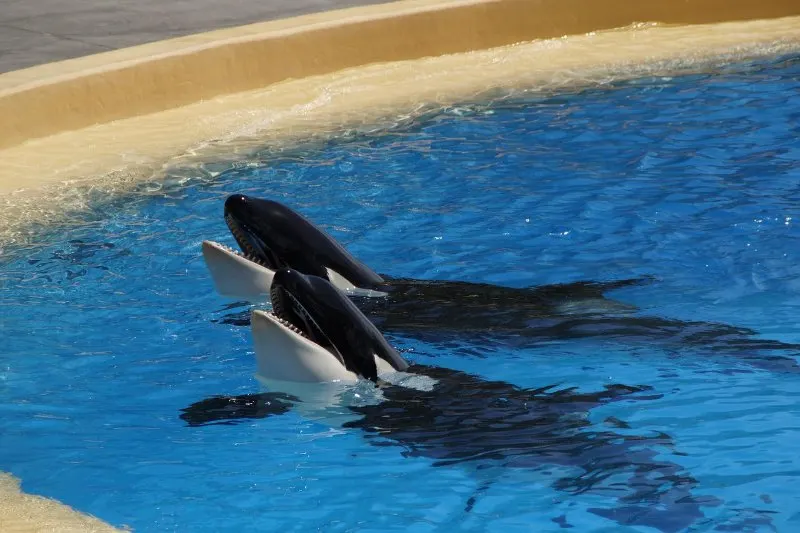
Who knew?!
The infamous Orca belonged to the Delphinidae family – and is a type of dolphin! Despite being so large and showing not-so-typical-dolphin-like behavior, Orcas are a type of oceanic dolphin.
Orcas are the largest dolphin species. These predatory mammals live in almost all of the Earth’s oceans, including arctic regions. Orcas are so diverse that scientists have determined four different types of Orcas around the world.
Orcas can grow up to 26 feet (or 8 meters) and weigh around 7,000 pounds (or 3,175 kgs). However, being so large, they can be very elusive, primarily because of their predation style.
Killer whales are apex predators, and nearly no natural predator has been found that feeds on Orcas. Orcas on the other hand have few qualms about eating everything else!
Status: Despite all of these, Orcas are slowly declining in population due to humans, and they are declared endangered by the IUCN.
See Related: The Different Types of Manatees
27. La Plata Dolphin, Franciscana (Pontoporia blainvillei)
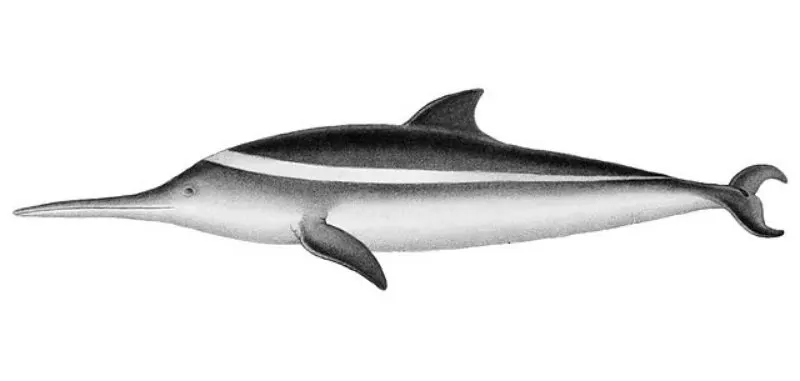
Endemic to the coastal waters of the Atlantic around southeastern South America, the La Plata Dolphin or Toninha Dolphin is a river dolphin that can survive in oceanic waters.
Boasting the most extended beak of any cetacean, the La Plata dolphin can grow up to 6 feet. Having a greyish brown color, these dolphins have two enormous flippers.
La Plata dolphins are very shy and very rarely seen near the shore. Pods of La Plata dolphins move very slowly and smoothly. Their diet includes fish, squids, octopus, and shrimp.
Status: These gorgeous dolphins are one of the most endangered dolphin species. The IUCN has put the La Plata Dolphin as a vulnerable species.
See Related: Fun, Interesting Facts about Whales
28. Long-Beaked Common Dolphin (Delphinus capensis)
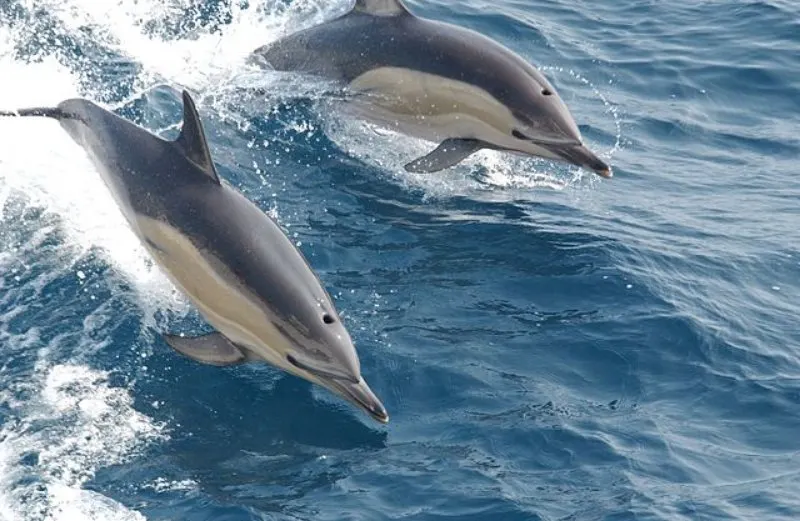
One of the most common dolphin species, the Long-Beaked Common Dolphin, is found in almost every ocean on the planet. These common dolphins have a considerable population and a vast geographic range and are relatively abundant in the wild.
It is a medium-sized dolphin with a deep black-colored back and a light grey belly. Unlike the common bottlenose dolphins, long-beaked common dolphins are not kept in captivity.
Long-beaked common dolphins are as friendly and intelligent as the bottlenose dolphin, so they are not a popular choice for zoos and aquariums.
Status: The IUCN considers the long-beaked common dolphin as a species of most minor concern as this species is widely spread, and its population seems to have a flat rate.
See Related: What is the Goal of Wildlife Conservation?
29. Long-finned Pilot Whale (Globicephala melas)
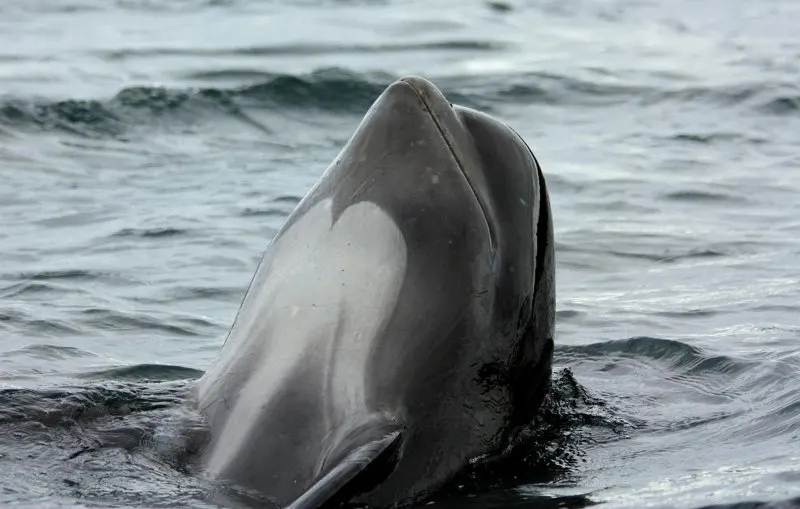
Although named a whale, the Long-Finned Pilot Whale is a type of dolphin just like the Orca. The similarly looking short-finned pilot whales are often confused with this different species of dolphin.
Their natural habitat is mainly around the northern and southern Atlantic Ocean, the, and the southeastern pacific ocean. A well-rounded, melon-like head often makes a long-finned pilot whale look like a beluga. But the dark complexion of a long-finned pilot whale distinguishes them from belugas.
Status: IUCN addresses this dolphin species as a species of most minor concern. Long-finned pilot whales are spread in multiple oceans peacefully. But their presence is prominent in the North Atlantic region.
See Related: Sperm Whale: Is This Animal Endangered?
30. Melon-headed Whale (Peponocephala electra)
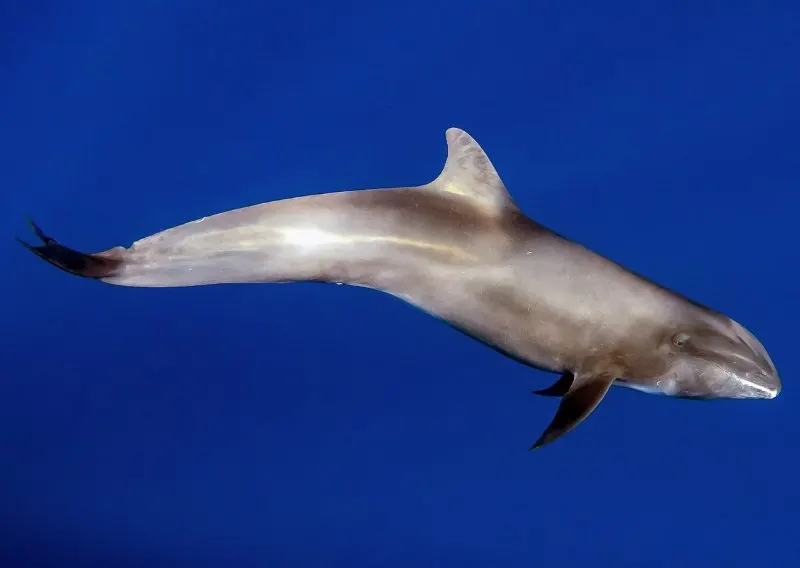
Commonly known as Electra Dolphins, Melon-Headed Whales are visibly striking and have a unique physical appearance. Melon-headed whales are a type of toothed whales. With a minor population around Hawaii and the Philippines, the Electra dolphins prefer the subtropical and tropical waters.
Melon-headed whales have no beak. But they have a large, spherical head and a black body. The well-defined sickle-shaped dorsal fin is very distinguishable. These whales move in large and clustered pods around the globe.
Status: IUCN marked the Electra dolphin as a species of most minor concern.
See Related: How Do Animals Adapt To Their Environment?
31. Northern Right Whale (Lissodelphis borealis)
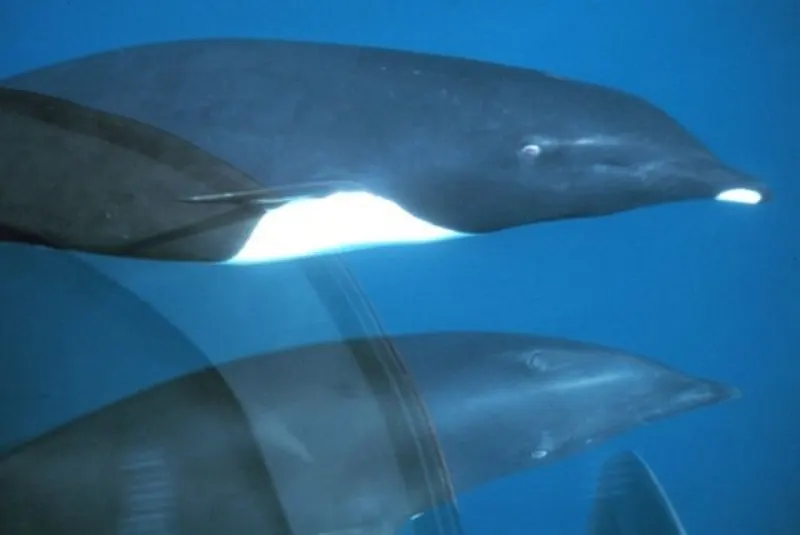
Not to be confused with the Southern Right Whale, Northern Right Whales are tiny, sleek, and finless. They mainly inhabit the cold waters of the North Pacific Ocean.
These temperate whale dolphins have sleek, streamlined bodies and sloping foreheads. The northern right whale dolphin is generally dark grey, brown, or cream-colored. The short, well-defined beak and tiny, curved, pointy flippers are easily distinguishable.
Status: The IUCN has enlisted the northern right whale dolphin as a species of most minor concern.
See Related: Most Endangered Species in Canada
32. Pacific White-Sided Dolphin (Lagenorhynchus obliquidens)
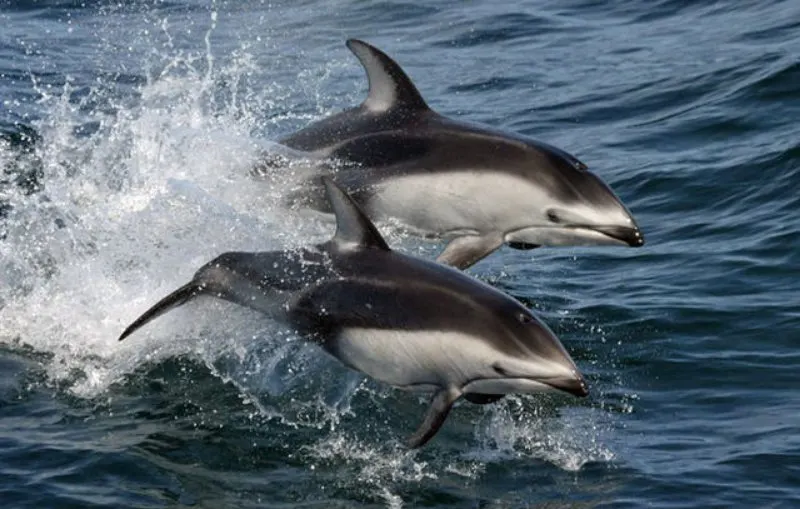
Commonly known as the Hookfin Porpoise, Pacific White-Sided Dolphins are active and playful dolphins widely found in the North Pacific Ocean’s temperate waters. These dolphins are a type of porpoise species with distinguishable traits.
These dolphins have three distinguished colors. The upper body, including the chin, throat, and belly, is somewhat creamy white. The beak, flippers, and fins are dark grey or black.
Pacific white-sided is very active and often seen interacting with other dolphin species. They are very docile and often seen executing summersaults. Pacific white-sided dolphin is fond of traveling in large groups.
Status: The IUCN has tagged the pacific white-sided dolphin as a species of most minor concern.
See Related: Ways to Save Animals Facing Extinction
33. Pantropical Spotted Dolphin (Stenella attenuata)
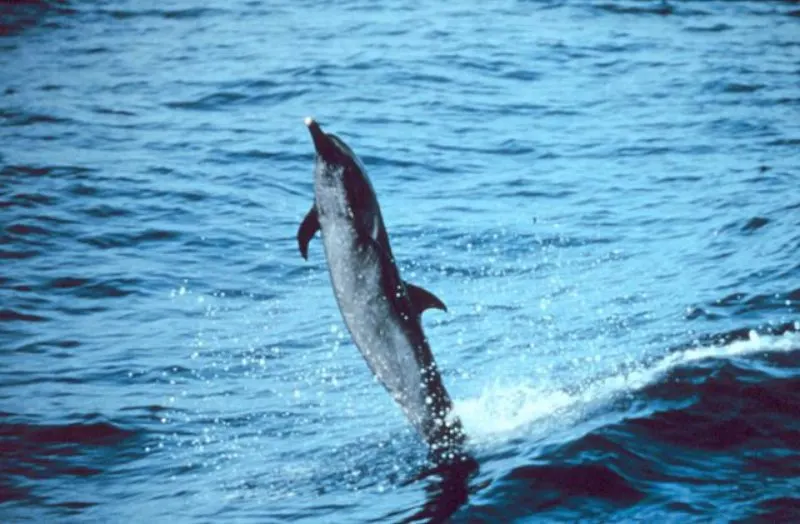
Pantropical Spotted Dolphins are commonly found all around the world, mainly in temperate and tropical waters. They are now one of the most abundant dolphin species.
Pantropical spotted dolphins look similar to other dolphin species, only discernable by their iconic spots or patches. They have a sleek body with a dark cape and mild patches on their body. In addition, they have a noticeable long yet thin beak and a curved dorsal fin.
Status: The IUCN enlisted the species as a species of most minor concern. This breed of dolphins has an overall 4% population growth every year.
34. Peale’s Dolphin (Lagenorhynchus australis)
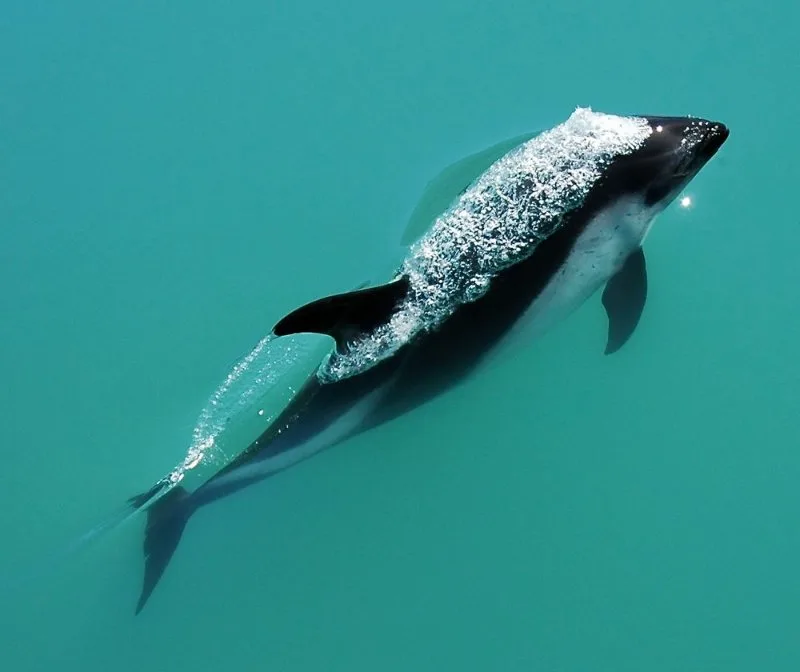
Commonly known as the Black-Chinned Dolphin, the Peale’s Dolphin is a tiny dolphin that dwells around the Tierra del Fuego in South America. Often confused with dusky dolphins from afar, Peale’s dolphins have larger white patches on their tummies.
Peale’s dolphins like to roam around in small groups near various bays and channels. They want the fast-streaming waters and usually stay near the shore areas.
Status: The IUCN has little data on this species, but they consider Peale’s dolphins a species of most minor concern.
35. Pygmy Killer Whale (Feresa attenuata)
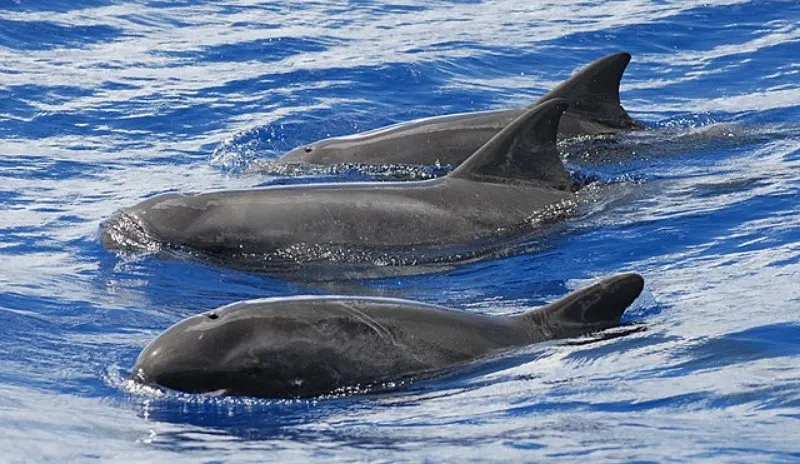
Pygmy Killer Whales are yet another species of dolphins we barely know about. It has similarities with the Orca (or killer whale). Pygmies are way smaller in size. In fact, they are one of the smallest species with the name “whale.”
These whales might lack size, but they certainly don’t lack aggression. The dark grey to black colored dolphins has white lines extended back to the face and a large dorsal fin. They also belong to the toothed whale family.
Pygmy killer whales are often seen in groups in the eastern tropical waters of the Pacific Ocean. However, if you want to visit these pygmy whales, visiting the coastal waters of Japan and Hawaii would save you some trouble.
Status: Although these animals are rarely seen, and we have very little data on them, the IUCN labeled them as species of most minor concern.
See Related: Animals With The Best Sense of Smell
36. Risso’s Dolphin (Grampus griseus)
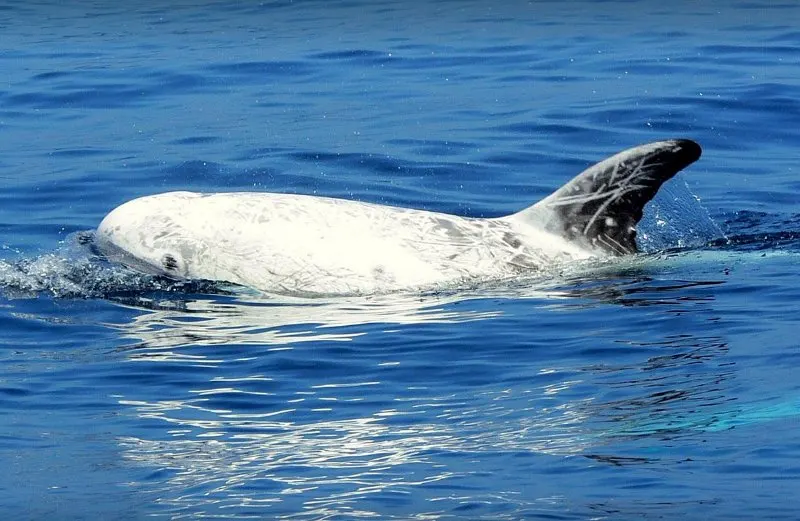
Risso’s Dolphin is a dolphin species closely related to pilot whales or melon-headed whales. Their natural habitats include temperate and tropical waters like the Indian, Pacific, and Atlantic oceans.
Risso’s dolphin is a relatively large breed of dolphin that can weigh up to 1,000 lbs (or 500 kgs). Their bulbous head has a significant vertical bulge. The dorsal fin is seen as prominent in adult dolphins.
Risso’s dolphins hunt mainly squids and small oceanic creatures. These aquatic mammals are social and like to travel in pods.
Status: The IUCN has listed Risso’s dolphins as a species of most minor concern.
See Related: Reasons Why Animals Should Not Be Kept in Zoos
37. Rough-Toothed Dolphin (Steno bredanensis)
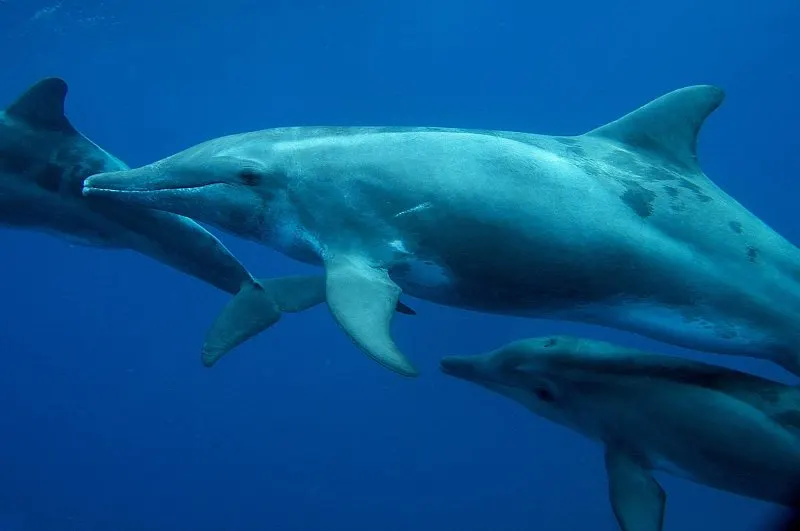
The Rough-Toothed Dolphin is a marine mammal traversing through the tropical and temperate waters of the planet. This Dolphin species is often seen in deep waters, so you will barely notice them near the shore.
The iconic rough teeth of these dolphins distinguish them from every other species. The unusual white or pink lower jaw does not quite match its grey skin. Rough-toothed dolphins are pretty large and have conical heads and slender noses.
They prefer traveling in a group of 10 or 20. Rough-toothed dolphins are rather social animals and often show signs of deep altruism.
Status: The IUCN considers the rough-toothed dolphins as a species of most minor concern.
38. Short-beaked Common Dolphin (Delphinus delphis)
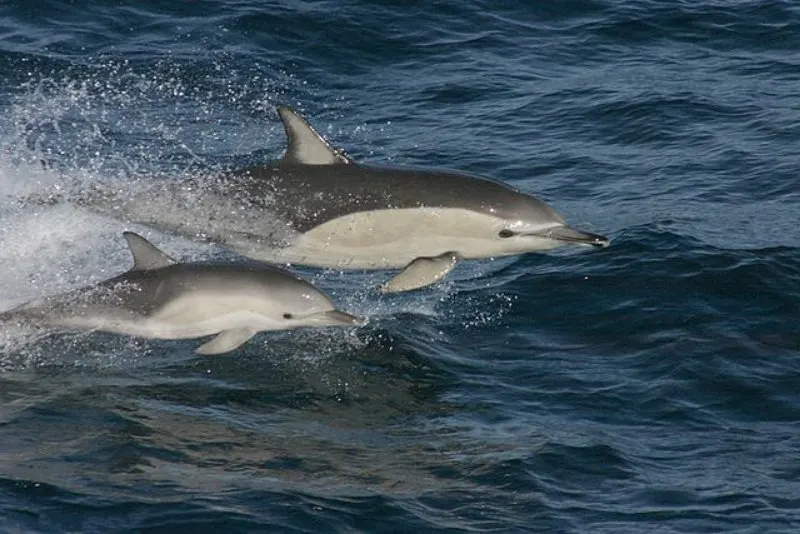
Another everyday dolphin – actually the dolphin portrayed the most in human culture, is the Short-Beaked Common Dolphin. Short-beaked dolphins are highly social and playful dolphins.
Short-beaked common dolphins are abundantly found in warm tropical waters. However, calm temperate waters are also excellent habitats for this type of dolphin.
Measuring under only 6 feet, a short-beaked common dolphin is relatively small, weighing only 170 pounds.
The slender, streamlined body with a sharp, triangular dorsal fin on the back makes the short-beaked common dolphin easily identifiable from others. These oceanic dolphins tend to roam in small pods and forage for food together.
Status: IUCN listed the small beaked common dolphin under the species of most minor concern as they are ubiquitous in the ecosystem.
39. Short-finned Pilot Whale (Globicephala macrorhynch)
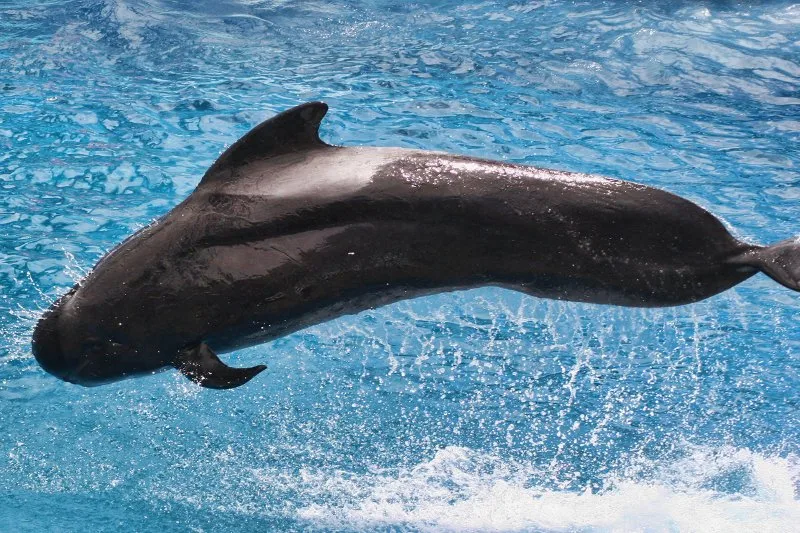
With a global population of 70,0000, the Short-Finned Pilot Whale is a super active and energetic mammal. Not to be confused with long-finned pilot whales, short-finned pilot whales are usually found in coastal and pelagic areas of the Indian, Atlantic, and Pacific oceans.
With a black or dark grey-colored body, short-finned pilot whales have bulbous heads with a sickle-shaped dorsal fin. This pilot whale can grow up to 6 feet and weigh up to 60kgs.
Short-finned pilot whales have an active social life and matriarchal family system. Pilot whales frequently interact with humans near the shore and show playful activities.
Status: The IUCN lists short-finned pilot whales as a species of most minor concern.
40. Southern Right Whale (Lissiodelphis Peronii)
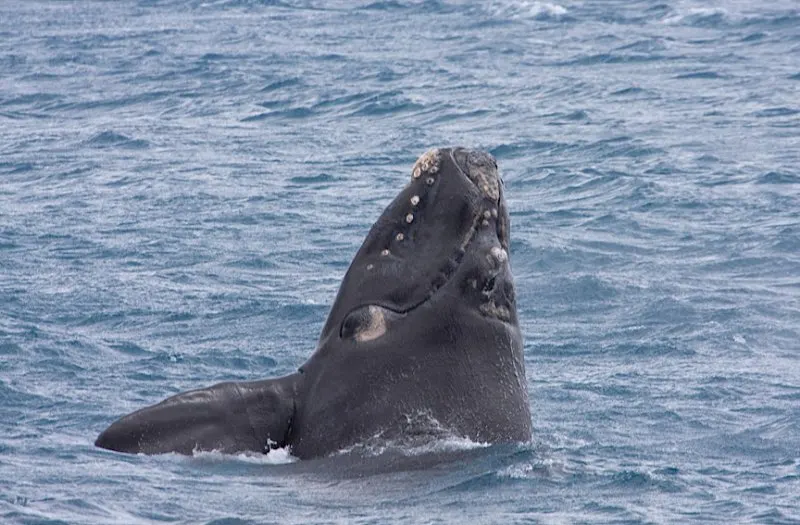
Southern Right Whales are exclusive to the chilly waters of the southern hemisphere. As a result, this medium-sized cetacean is easily distinguishable from most other dolphins.
These dolphins do not have a dorsal fin. Instead, with a very sleek body, their black back, and white belly make them easily identifiable in the wild.
These dolphins dwell in the remote waters of Cape Horn, southern Africa, and Australia.
Status: Scientists have sporadic contact with these dolphins; hence there is very little data to determine their threat level. The IUCN has tagged the southern right whale dolphin as a species of most minor concern.
See Related: How Do Animals Adapt to Their Environment?
41. Spinner Dolphin (Stenella longirostris)
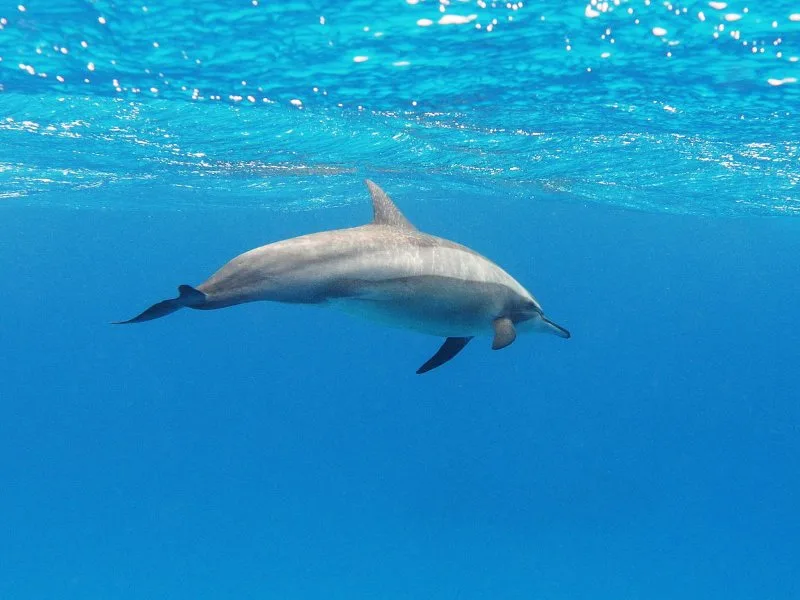
Exclusive to tropical and subtropical waters, the Spinner Dolphin is a famous acrobatic small-sized dolphin. The spinner dolphin is well known as the long-snouted dolphin.
Their signature move is jumping out of the sea and spinning around in the air. Hence, the name spinner dolphin.
Morphologically, spinner dolphins have slender bodies with aerodynamic fins, allowing them to spin up to 10 times mid-air. That’s quite an impressive feat, even for a dolphin!
Status: The spinner dolphin is a species of most minor concern by the IUCN.
42. Striped Dolphin (Stenella Coeruleoalba)
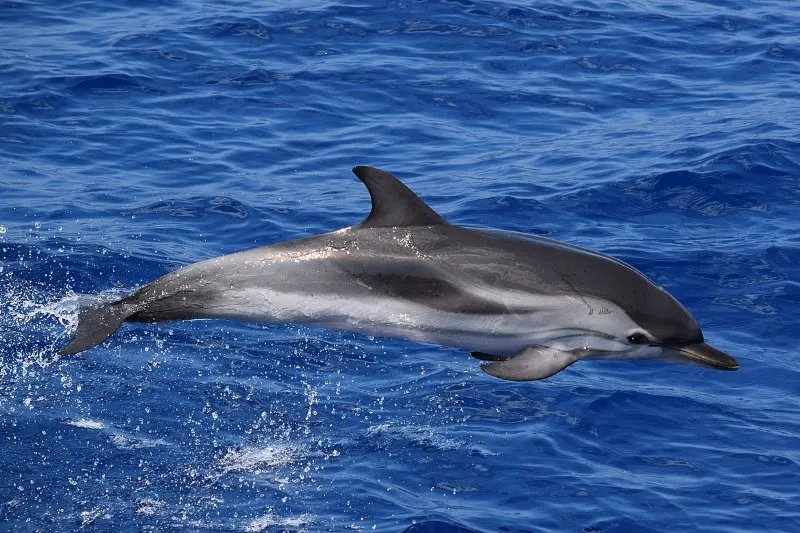
The Striped Dolphin is a well-studied aquatic mammal primarily found in the planet’s tropical and temperate waters. Their major habitats include the Gulf of Mexico and the Atlantic Ocean.
Striped dolphins often have a black or grey back with blue, pink, or white underbellies. In addition, they have their signature white stripes separating their back and belly.
Striped dolphins are very familiar with people. They are also quite fond of humans.
Status: The IUCN has listed the species as a species of most minor concern.
43. Tucuxi (Sotalia Fluviatilis)
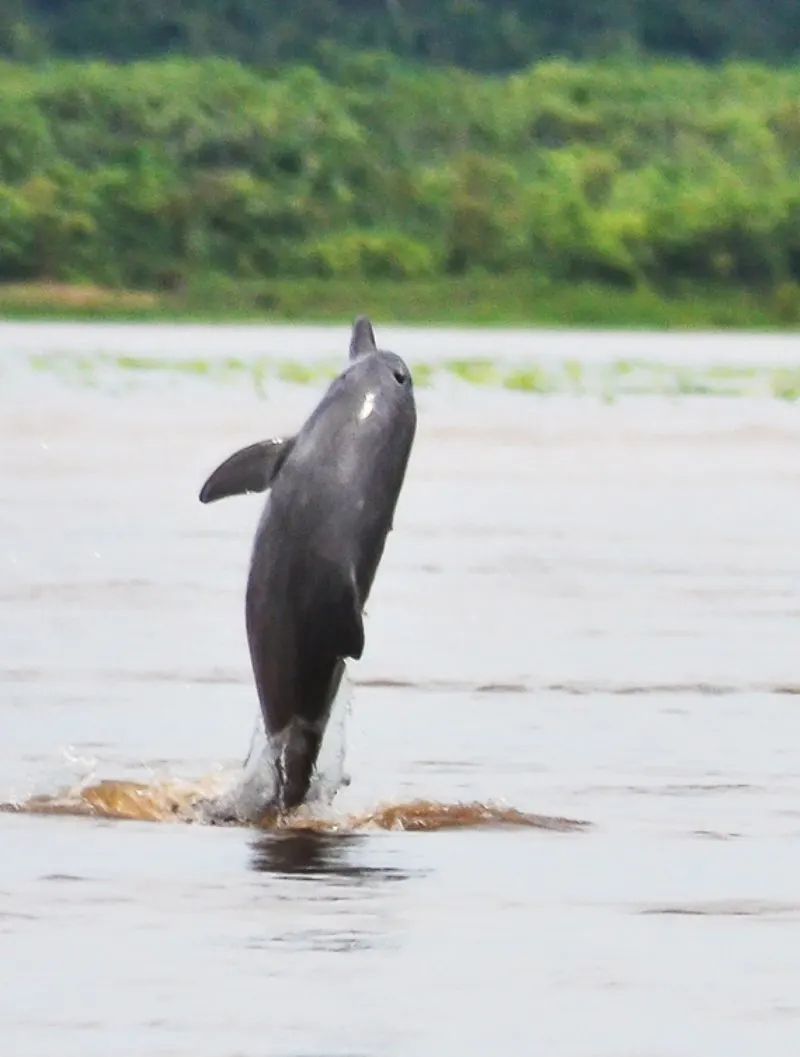
The Tucuxi is a cute and sweet dolphin species endemic to the Amazon River basin. Although it is a river dolphin, its physical structure resembles the oceanic bottlenose dolphin.
It is a small-sized dolphin with a short snout and round head. The Tucuxi has a fair, pinkish complexion which sets it apart from other river dolphins.
Status: The Tucuxi is considered an endangered species. Their population is decreasing at an alarming rate due to human interference and pollution.
44. White-Beaked Dolphin (Lagenorhynchus albirostris)
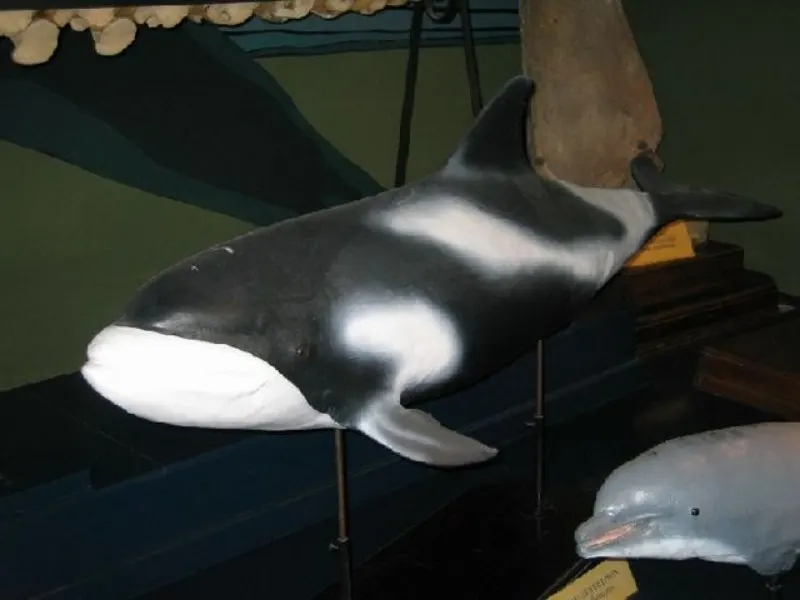
Endemic to the cold waters of the North Atlantic Ocean subarctic waters, the White-Beaked Dolphin is a large dolphin with relatively short beaks. White-beaked dolphins are often mistaken for the Atlantic white-sided dolphin. But the white-beaked dolphins do not have yellow stripes on its side.
The upper body is colored dark grey, while the lower body exhibits light grey to white coloring. Their dietary habits include gadoid fishes like cod, haddock, and whiting. White-beaked dolphins show exquisite acrobatic skills.
Status: Proliferating peacefully in the remote Arctic waters, white-beaked dolphins are listed as a species of most minor concern by IUCN.
See Related: Five-Letter Animals to Know Around the World
Final Thoughts
How many different types of dolphins are there in the world? An ever-dwindling number.
Dolphins are intelligent and smart marine mammals. They are rooted deeply in the ecosystem of this planet. The aquatic ecosystem depends on dolphins; these elegant animals are classically significant.
Unfortunately, due to human invasion, pollution, and hunting, how many species of dolphins are there endangered or on the verge of extinction? We don’t have sufficient data on them.
It’s high time we took action to ensure these beautiful creatures’ safe survival. We need some critical habitats to conserve these dolphin species. We should deal with the widespread water pollution.
We should ban any sort of hunting of dolphin species. Then we can think of a balanced ecosystem.
FAQ
Are dolphins their own species?
There are many different species of dolphins, which are all part of the same family as whales, dolphins, and porpoises.
How many dolphins are there in the world?
In all species combined, the numbers are in the millions, but there are some species where the numbers may only be in the tens. The critically endangered Irrawaddy Dolphin may number less than 100.
How many species of dolphin are there?
Depending on who you ask, between 40 and 49. We’re going with 44 that most experts agree on as being actual dolphin species.
Related Resources
- Types of Sharks Around the World
- Different Types of Turtles Around the World
- Different Types of Bears From Around the World


